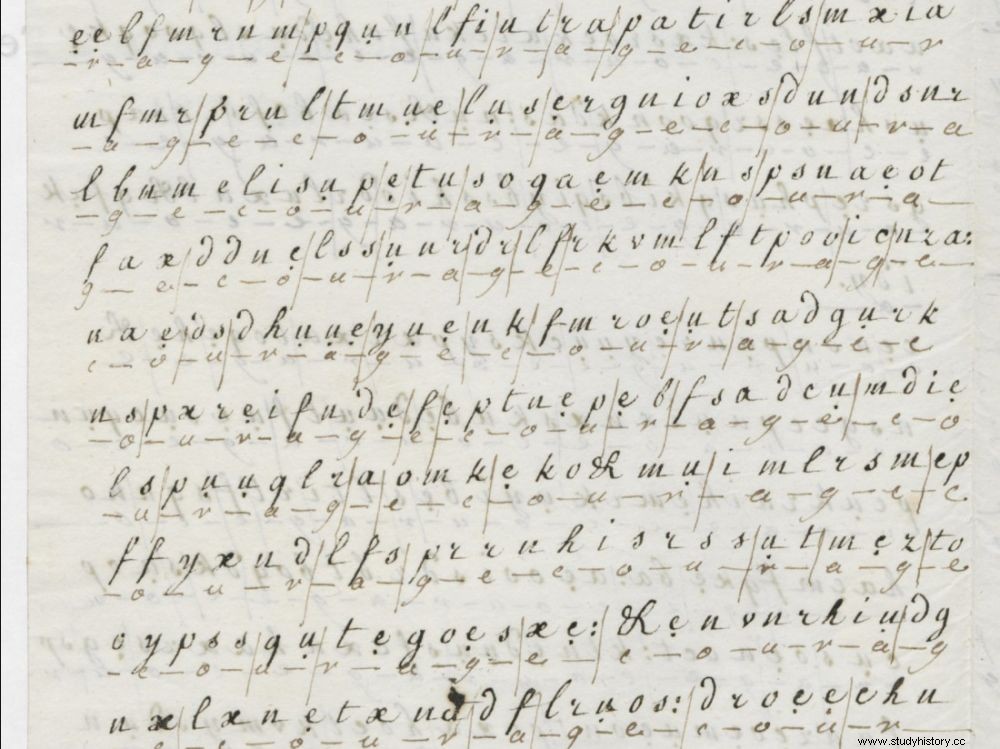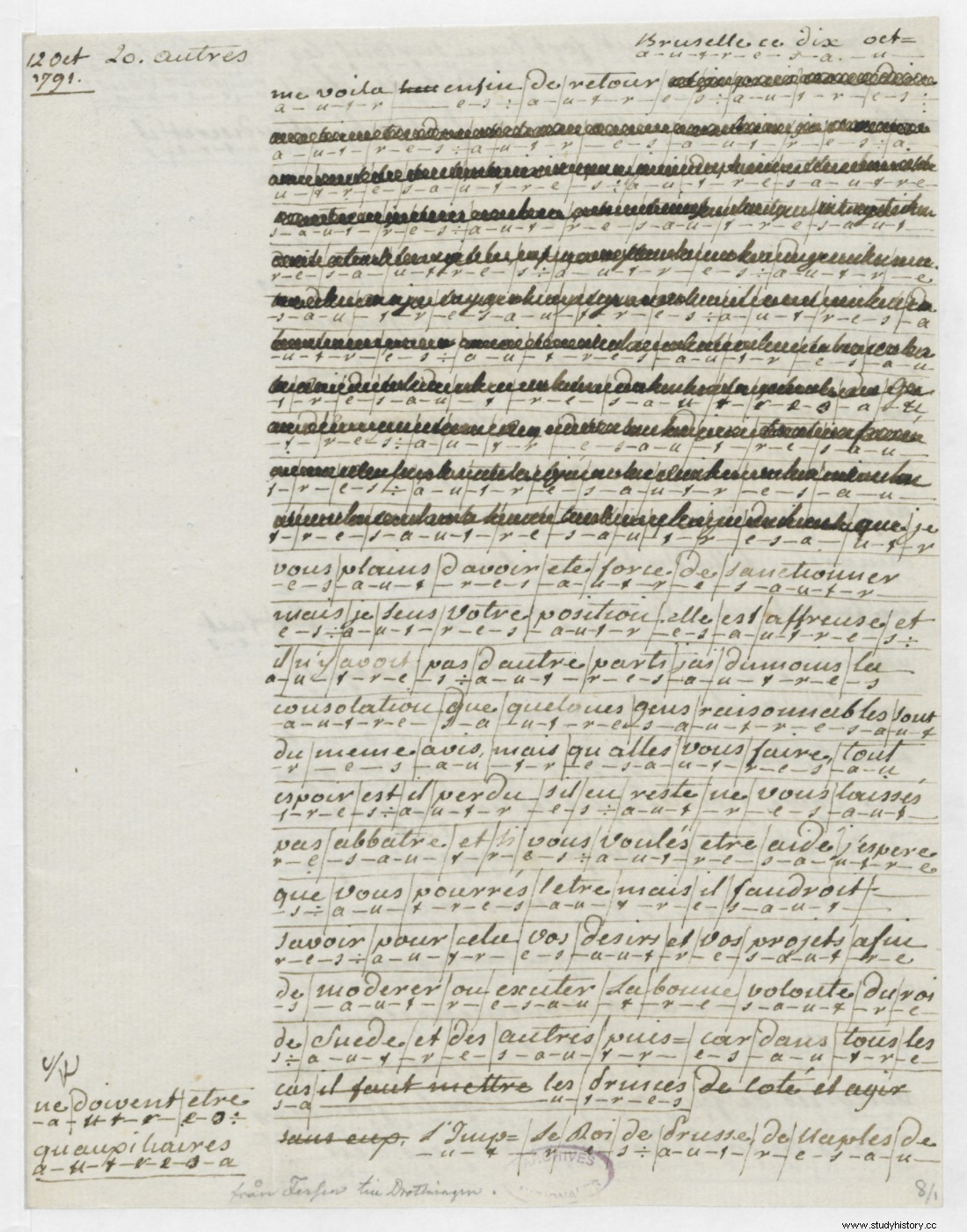These secret - and coded - letters from Marie-Antoinette were addressed to the Count of Fersen, a Swedish officer.

The coded letters of Marie-Antoinette.
UPDATE. During the French Revolution, Marie-Antoinette, wife of Louis XVI, maintained a secret correspondence with Count Axel de Fersen. An unidentified person then censored parts of these letters. In an article published on October 1, 2021 in the journal Science Advances , three French researchers from the Center for Research on Conservation (CRC) explain that they have found a methodology to reveal the hidden content of certain missives and perhaps find the identity of this person. "X-ray fluorescence spectroscopy was used in macroscan mode on redacted sections, reveals the study. Specific data processing has been applied to improve the readability of hidden writings ". Through this protocol, the researchers revealed the censored content of eight letters out of 15. "As for the remaining seven documents, all the methodological tools presented failed to recover any of the censored writings ", note the researchers. In question:very similar inks to write and then to censor which complicates the identification of the hidden words. In addition, the researchers believe that the count Axel de Fersen could be himself responsible for the censorship of certain letters."If our hypothesis is validated, this would explain why the last letters could not be read ", add the authors of this new study. Indeed, if it is indeed the Count of Fersen, "then the writing and censoring inks are identical, which makes it impossible to distinguish them by spectroscopy ". "He decided to keep his letters instead of destroying them but redacting certain sections, indicating that he wanted to protect the Queen's honor (or perhaps also his own interests )", concludes the study. Science and Future devoted a survey to this ongoing research in 2014 which we are republishing below.
PASSIONATE EXCHANGES. "I exist my beloved and it is to adore you "; "Farewell, most beloved of men "; "I will love you till I die "… These passionate exchanges are among the most secret letters in the history of France. Fruit of a hidden affair between Queen Marie-Antoinette and Count Axel de Fersen, they will be put online - including the decryption table -, end of January 2014 on the website of the National Archives.
Everyone will thus be able to have access, for the first time, to these burning letters exchanged between the Queen of France and the young Swedish officer from June 1791 to August 1792, i.e. two years before the death of the sovereign on the scaffold... On condition of love crypto! Because, if some of these missives were written in sympathetic ink, most were scrupulously coded so that no prying eyes could ever read them! This precious correspondence, which was believed to be partly destroyed, was the subject of a presentation on January 7, 2014 in Paris, during the inaugural session of the series of conferences "Trésors du Patrimoine Écrit> " organized by the National Heritage Institute and the National Archives. The opportunity for the public to discover all the little-known wealth.
Letters encrypted according to the "poly-alphabetic" code
Some of these missives, decrypted, had already been published in 1877 by the nephews and great-nephews of the Count of Count de Fersen. But on the occasion of these meetings, the cryptologists Valérie Nachef, lecturer in mathematics at the University of Cergy-Pontoise and Jacques Patarin, professor at the University of Versailles, presented a new reading of these letters acquired by the National Archives between 1982 and 1992 following sales made to Fersen's descendants.
KEYWORD. To correspond, the queen and her lover used a complex code, called "poly-alphabetic", requiring two elements to be decrypted:a decryption table and a keyword that changed with each message. No one knows today how Marie-Antoinette and Axel de Fersen went about exchanging the keyword. We sometimes speak of codes sewn into the linings of hats, or caches in secretaries. Still, the work of writing, and deciphering, proved long and tedious, which the queen will end up complaining to Fersen in a letter dated November 2.
"Nothing in the world can prevent me from adoring you until death"
Several "unpublished" passages have also been revealed by the patient work of Valérie Nachef and Jacques Patarin, proving the undeniable nature of the affection - to put it mildly - between the queen and the young count.

A letter from Fersen, with passages crossed out. Credit:National Archives.
Thus on June 29, 1791:"…nothing in the world can prevent me from adoring you until death ". They also reveal the sovereign's great concern about the future and her maneuvers to try to forge alliances with foreign powers to restore the monarchy. Fersen was moreover one of the instigators of the famous "leak to Varennes" on June 21, 1791 during which the royal couple and their children attempted to leave France.
Thus these extracts from a letter which remained unknown for a long time, dated July 9 (the year does not appear):only harm. We must give in to the storm. We wouldn't have time to be rescued]… [Love me]… [I want you not to go to Vienna, to stay with the king and that in everything you appear as little as possible]….[Farewell. Pity me. Love me. Especially in judging me in all that you see me do only after having heard me. I will die if I was for a moment disapproved of by the being I adore and will never cease to adore] … ".
REDACTED PARTS. Valérie Nachef and Jacques Patarin now want to go further to decipher what is hidden under the crossed out parts of Fersen's letters (see photo). Contacts have just been made with the C2RMF laboratories of the Louvre Museum, as well as the CEA/LETI of Grenoble, laboratories specialized in the study of historical documents and works. The means of physical and optical analysis available to these important research centers will perhaps make it possible to be able to dissociate the different inks:Those of lovers, of those who have tried to delete certain passages.
